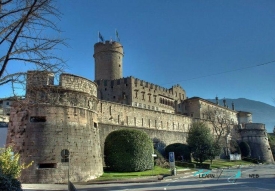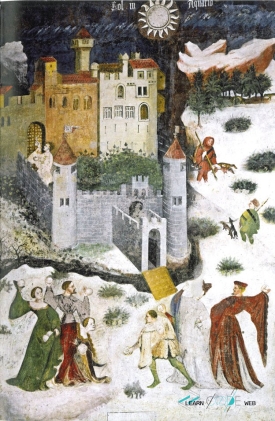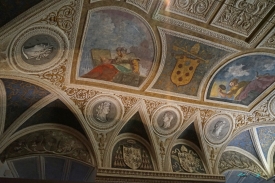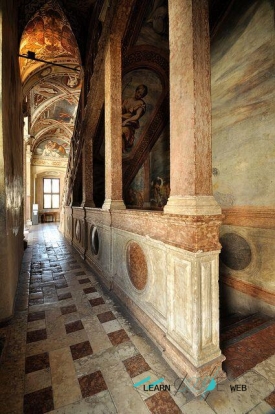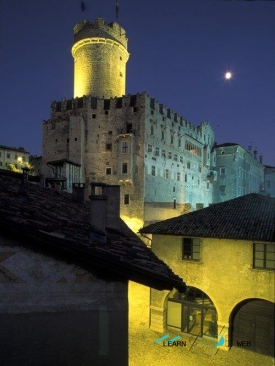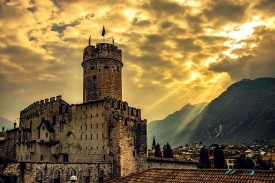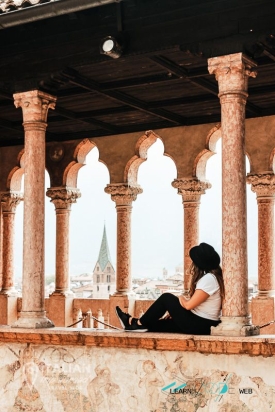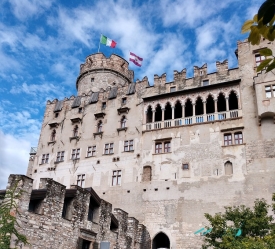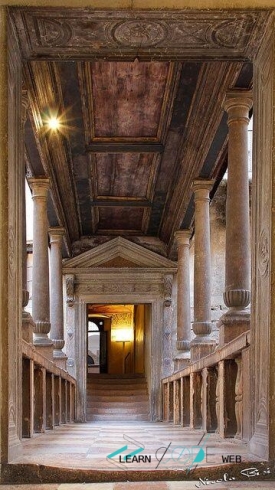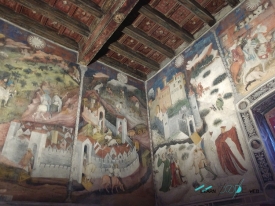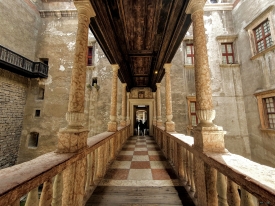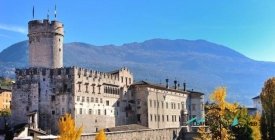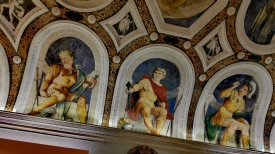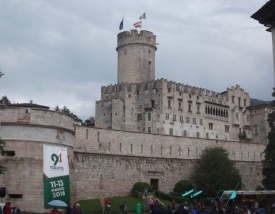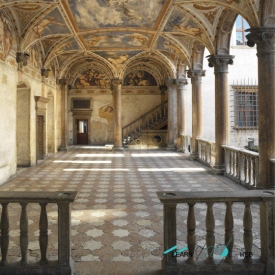The Buonconsiglio Castle is one of the best-known buildings in Trento and one of the main monumental complexes in Trentino-Alto Adige. From the 13th century to the end of the 18th century, the residence of the prince-bishops of Trento is made up of a series of buildings from different periods, enclosed within a walled enclosure in a slightly elevated position with respect to the city. Castelvecchio is the oldest nucleus, dominated by a powerful cylindrical tower; At the southern end of the complex is the Torre Aquila, which houses the famous "Cycle of the Months", one of the most remarkable pictorial cycles on a secular theme of the Italian Late Middle Ages.
The Magno Palazzo is the 16th-century extension in Italian Renaissance form, commissioned by Prince Bishop and Cardinal Bernardo Clesio (1485-1539); An important Mannerist pictorial cycle is preserved in excellent condition. The baroque Giunta Albertina dates back to the end of the 17th century.
The castle was built for defensive functions on a rock relief, originally the site of a Roman castrum.
The hill where the fortress was built from the 13th century was called Malconsey, a name still used in 1381 by Bishop Albert of Ortenburg. From the 14th century, the place name that in ancient times indicated the small hill ceased to be used and the original name was changed, adopting a more positive term: Malconsey Castle became Buonconsilii (of the Buonconsiglio).
Its current structure is the result of an aggregation of centuries-old buildings: in fact, different sections and structures are clearly distinguished, dating from different centuries. Buonconsiglio Castle is one of the largest fortified complexes in the Alps.
The oldest part is in the Romanesque style, represented by the core of Castelvecchio from the 13th century (later rebuilt in 1440) and the large circular tower (called Torre d'Augusto). At a later stage, between the end of the 14th century and the beginning of the 15th century, the structure was profoundly modified by the prince-bishops George of Liechtenstein and John IV Hinderbach. The first connected the tower of Aquila with the Castelvecchio, which he frescoed with the Cycle of the Months, an extraordinary example of International Gothic. Giovanni IV Hinderbach had the great battlements and the loggia built in Venetian-Gothic style.
In 1500, Cardinal Bernardo Clesio, engaged in a project of urban restructuring and remodeling of the entire city, had a Renaissance building built to the south of the complex, the Magno Palazzo, the new house of the bishops, with frescoes by Dosso Dossi and Girolamo . Roman.
In the Baroque period, Bishop Francesco Alberti Poia built the Giunta Albertiana, a structure that allows direct communication between the medieval section and the Magno Palazzo.
In 1796 the city was invaded by Napoleonic troops and the last Prince Bishop, Pietro Vigilio Thun, left the castle and took refuge in the family fortress of Val di Non. With the secularization of the Episcopal Principality of Trento and its annexation to the County of Tyrol, the Buonconsiglio was reduced from a representative office to an Austrian military barracks.
Before the start of the Great War, the castle became part of the Fortress of Trent (Festung Trient). During World War I, the courtroom (the 16th century Stua della Famea) was the site of the trial (1916) of the irredentists Cesare Battisti, Fabio Filzi and Damiano Chiesa. After the sentence, which sanctioned the death penalty for high treason, the three irredentists were taken to the cells created in the lodge. The sentence was carried out in the meadow between the castle and the walls to the east (the Fossa dei Martiri): on May 19, 1916, Rovereto's second lieutenant Damiano Chiesa, a volunteer in the Italian army, was shot; Lieutenant Battisti and Lieutenant Filzi were hanged on the following July 12.
In 1918 the Italian State became the owner of the Castle, which passed to the Autonomous Province of Trento in 1974. The castle is a mansion of honor of the Order of Vittorio Veneto, appearing at the top left in the Knight's diploma.
Since 1973 the castle has been the seat of the regional art museum, also known as the Museo Castello del Buonconsiglio. Numerous art collections, ranging from paintings to tiled stoves, as well as archaeological and numismatic collections, are on display here. Among the valuable Baroque and Gothic frescoes is the so-called “Cyclo dei Mesi”, which belongs to the most precious frescoes in the world.
In addition to the precious frescoes, the castle houses collections from the National Museum. These include memorials and writings, 15th-century music, a 9th-century Gospel book, and a 9th-century Gregorian liturgical codex, as well as Carolingian sculptures, paintings, frescoes, and drawings.
The Magno Palazzo is the 16th-century extension in Italian Renaissance form, commissioned by Prince Bishop and Cardinal Bernardo Clesio (1485-1539); An important Mannerist pictorial cycle is preserved in excellent condition. The baroque Giunta Albertina dates back to the end of the 17th century.
The castle was built for defensive functions on a rock relief, originally the site of a Roman castrum.
The hill where the fortress was built from the 13th century was called Malconsey, a name still used in 1381 by Bishop Albert of Ortenburg. From the 14th century, the place name that in ancient times indicated the small hill ceased to be used and the original name was changed, adopting a more positive term: Malconsey Castle became Buonconsilii (of the Buonconsiglio).
Its current structure is the result of an aggregation of centuries-old buildings: in fact, different sections and structures are clearly distinguished, dating from different centuries. Buonconsiglio Castle is one of the largest fortified complexes in the Alps.
The oldest part is in the Romanesque style, represented by the core of Castelvecchio from the 13th century (later rebuilt in 1440) and the large circular tower (called Torre d'Augusto). At a later stage, between the end of the 14th century and the beginning of the 15th century, the structure was profoundly modified by the prince-bishops George of Liechtenstein and John IV Hinderbach. The first connected the tower of Aquila with the Castelvecchio, which he frescoed with the Cycle of the Months, an extraordinary example of International Gothic. Giovanni IV Hinderbach had the great battlements and the loggia built in Venetian-Gothic style.
In 1500, Cardinal Bernardo Clesio, engaged in a project of urban restructuring and remodeling of the entire city, had a Renaissance building built to the south of the complex, the Magno Palazzo, the new house of the bishops, with frescoes by Dosso Dossi and Girolamo . Roman.
In the Baroque period, Bishop Francesco Alberti Poia built the Giunta Albertiana, a structure that allows direct communication between the medieval section and the Magno Palazzo.
In 1796 the city was invaded by Napoleonic troops and the last Prince Bishop, Pietro Vigilio Thun, left the castle and took refuge in the family fortress of Val di Non. With the secularization of the Episcopal Principality of Trento and its annexation to the County of Tyrol, the Buonconsiglio was reduced from a representative office to an Austrian military barracks.
Before the start of the Great War, the castle became part of the Fortress of Trent (Festung Trient). During World War I, the courtroom (the 16th century Stua della Famea) was the site of the trial (1916) of the irredentists Cesare Battisti, Fabio Filzi and Damiano Chiesa. After the sentence, which sanctioned the death penalty for high treason, the three irredentists were taken to the cells created in the lodge. The sentence was carried out in the meadow between the castle and the walls to the east (the Fossa dei Martiri): on May 19, 1916, Rovereto's second lieutenant Damiano Chiesa, a volunteer in the Italian army, was shot; Lieutenant Battisti and Lieutenant Filzi were hanged on the following July 12.
In 1918 the Italian State became the owner of the Castle, which passed to the Autonomous Province of Trento in 1974. The castle is a mansion of honor of the Order of Vittorio Veneto, appearing at the top left in the Knight's diploma.
Since 1973 the castle has been the seat of the regional art museum, also known as the Museo Castello del Buonconsiglio. Numerous art collections, ranging from paintings to tiled stoves, as well as archaeological and numismatic collections, are on display here. Among the valuable Baroque and Gothic frescoes is the so-called “Cyclo dei Mesi”, which belongs to the most precious frescoes in the world.
In addition to the precious frescoes, the castle houses collections from the National Museum. These include memorials and writings, 15th-century music, a 9th-century Gospel book, and a 9th-century Gregorian liturgical codex, as well as Carolingian sculptures, paintings, frescoes, and drawings.



